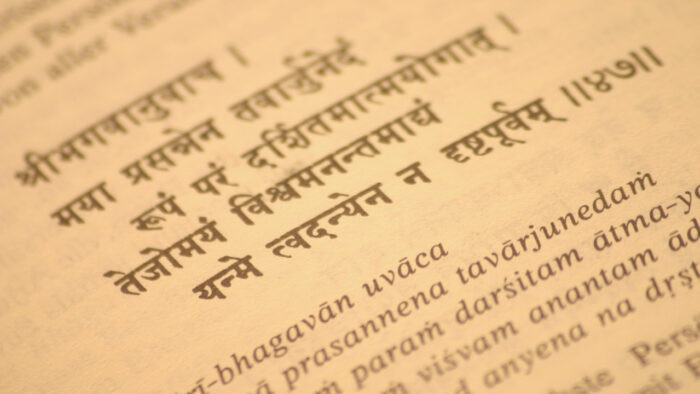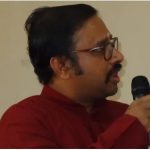Indian Knowledge Systems, popularly known as IKS, has deep rooted association with the Sanskrit language. It is not at all coincidental that a significant knowledge base of Sanātana Dharma is represented in Sanskrit. In its structural framework, vocabulary, grammar, tone, expression, metre, declensions and varied forms, Sanskrit is designed to represent the very essence of Dharma. It is a language born of Dharma, existing for Dharma, and guided by the principles of Dharma.
To elaborate this further:
- Sanskrit language created a significant body of knowledge in Bhārata, covering a wide spectrum of life, before the advent of the colonial era/industrial revolution.
- Sanskrit has been a great unifier and a common feature across the Bhāratavarṣa geography over millennia. It has enabled the migration of people from one region to another seamlessly in the pre-Hindi/English era.
- Sanskrit itself is a Civilizational feature of Bhāratavarṣa. The sound, the word formation, the language architecture and computational features of Sanskrit language stand unique in the world. It is as much Sanātana as the Civilization itself is.
- Sanskrit is largely the source language of all that is Dharma and Mokṣa.
- Sanskrit has created a capacity for several other Bhāratīya Bhāṣās to take root, grow and thrive, even as Sanskrit continued to thrive as a pan-Bhāratavarṣa language. It never came in the way of other languages or sought to destroy them. Instead, it has nurtured their Dharma orientation. Under its cultural cover, Bhāratīya Bhāṣās discover their Swadharma and undertake their natural journeys.
Indulgence in Sanskrit is required to not merely access our existing corpus, but it is also vital for building a new future firmly rooted in Dhārmika ethos as we undertake the restoration and reconstruction of our civilization. It is the language of IKS & foundation over which alone an IKS future is possible. It is the bedrock over which all IKS Initiatives must be run for success and impact. A grand resurgence of Sanskrit can serve as the single most powerful catalyst for driving every single objective in IKS. Thus, Sanskrit is a strategy for IKS.
Although ‘Secularism’ pushed out Sanskrit from the mainstream it was not that bad until the 1990s. During the initial four decades of independence, many States offered Sanskrit as the first language and hundreds of students graduated with foundational understanding of it. Somehow 1991 changed everything unwittingly. Modern Industry subconsciously elevated English as the most important language, overshadowing other Bhāratīya Bhāṣās. Leaders of Industry too overindulged in English rhetoric. Livelihood concerns forced students to de-prioritise even their mother tongue, leave alone Sanskrit! Thus, what should have been our national language was pushed away into an insignificant corner for two decades.
Thankfully, in the last 10 years, it has made a comeback. Interestingly, it is technology which has enabled this resurgence. What was lost in schools was regained through online courses offered by various Institutions. INDICA has been one of the pioneers in offering Sanskrit Courses. In fact a luminary mentioned to me in a private conversation that there has been a general increase in enthusiasts to learn Sanskrit over the past few years. Of course, in the meanwhile, Gurukulams, Achāryas, families with the unwavering Śraddhā have stood the ground and anchored Sanskrit learning despite sidelining and hostility. However, we are miles away from reaching a level sufficient enough to build a distinct future for us as a Civilization.
What we need is a “National Mission for Sanskrit”, to achieve our grand vision of Bhāratavarṣa. The success of all IKS Objectives depends on a much higher order of Curiosity, Confidence and Connect in Sanskrit as a language.
This Mission ought to have an objective of producing a specific number of Sanskrit-ready professionals at multiple levels. We must start from the highest expertise & come down to every individual in the society.
- PhD in Sanskrit or specific Shastras
- MA in Sanskrit
- Engineering Professors with Sanskrit Diploma or MA
- Performing artists, Cinema , Theatre and more content in Sanskrit
- 10th Standard Sanskrit at a third Language
- Sanskrit Speakers without degrees
- Performing artists, Cinema , Theatre and more content in Sanskrit
- ..and more
This is an indicative breakdown. I am certain subject matter experts of IKS could draw a totally different order, categorisation and skill sets.
This Mission, of course, will have to be drawn by the IKS Vision of the Nation. The Vision must be able to trigger an imagination of what we can achieve if a Mechanical/Computer Science Engineer knows Sanskrit or even a specific Śāstra. We already have a sizable population equipped with these skills but their potential remains underutilised. A good Vision Statement will enable a downstream articulation for what can be achieved in each discipline. What difference will it make if Industry leaders know Sanskrit? What must a CEO or a COO learn? How much Sanskrit should political leaders know? These are questions a well-constructed vision statement must answer, providing a roadmap for the strategic integration of Sanskrit across diverse professional domains.
The scale of this mission requires a robust Public-Private partnership with the State anchoring this through a National Policy. This also needs additional infrastructure investment in terms of tailor-made courses, applied learning material etc., that aids learning at multiple levels.
Languages are learnt in the following sequence a) Listening/Understanding b) Speaking c) Reading d) Writing. It is important to prioritise a higher proficiency in Listening and Understanding as compared to Writing skills. We need to build resources at all these levels. An exemplary example of this is the past practice of All India Radio which featured a daily 5-minute Sanskrit news segment of highest aesthetic quality.
संप्रति वार्ता: श्रूयन्ताम, प्रवाचक बलदेवानंद सागर:
“saṃprati vārtāh śrūyantām, pravācaka baladevānaṃda sāgarah”
These sweet words still ring in one’s ears. Just listening to the language every day exposes one to its beauty in the dimensions of vocabulary, rhythm and sound.
We need to incorporate all these facets into the National Consciousness. The National Policy must enable the development of these resources in a top-down & bottom-up manner. Over the next decade, a single-minded focus on increasing ‘Sanskrit appreciation’ at every level ought to be one of our biggest focuses. Allocating substantial resources to this endeavour will result in the necessary momentum being generated over which other things can ride. This means creating “Curiosity, Confidence and Connect” with Sanskrit at multiple levels. It must simply be visible and accessible seamlessly and in multiple ways. In particular, we need to create a fascination and wonder about Sanskrit – its features, flavour and faculties. Such a “National Mission for Sanskrit” is the need of the hour.
जयतु संस्कृतम् जयतु भारतम्
Feature Image Credit: istockphoto.com
Disclaimer: The opinions expressed in this article belong to the author. Indic Today is neither responsible nor liable for the accuracy, completeness, suitability, or validity of any information in the article.











